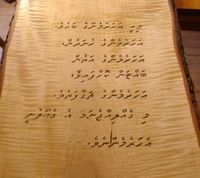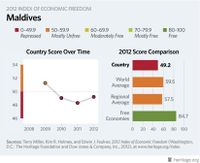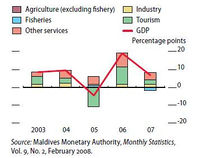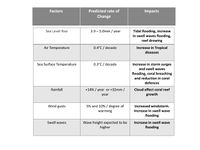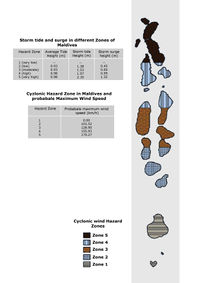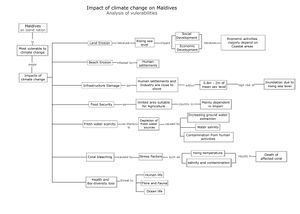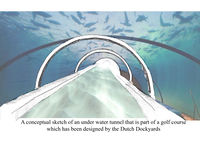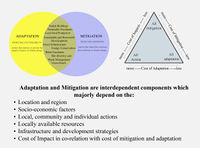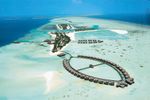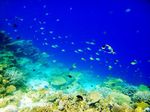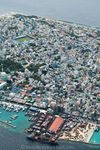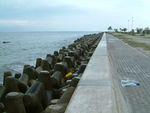Group L - Collaborative Climate Adaption Project: Difference between revisions
| (186 intermediate revisions by 3 users not shown) | |||
| Line 36: | Line 36: | ||
=== Rationale: Why have you selected this case study area? === | === Rationale: Why have you selected this case study area? === | ||
We decided on the Maldives for our case study, as it is a country that is very much defined by it's topographical and geographical references. More so than continental countries, island states have very limited natural resources and there for have to either rely on trade from the mainland or provide a service to generate wealth (e.g tourism). Today tourism is the biggest industry in the Maldives and accounts for more than 25% of the GDP. The second biggest in the country is the fishing industry, which unlike the tourist branch, has a much deeper grasp in the maldivian culture. Not only is fishing a way of life in the maldives, but fish also provide the main source of protein for the population. | We decided on the Maldives for our case study, as it is a country that is very much defined by it's topographical and geographical references. More so than continental countries, island states have very limited natural resources and there for have to either rely on trade from the mainland or provide a service to generate wealth (e.g tourism). Today tourism is the biggest industry in the Maldives and accounts for more than 25% of the GDP. The second biggest in the country is the fishing industry, which unlike the tourist branch, has a much deeper grasp in the maldivian culture. Not only is fishing a way of life in the maldives, but fish also provide the main source of protein for the population. | ||
This is where it becomes interesting. As the country needs grow economically, so it can support its populations needs, more waste is produced. As land is precious and there is no space to build proper waste refineries, the waste is burnt at low temperatures or dumped | This is where it becomes interesting. As the country needs grow economically, so it can support its populations needs, more waste is produced. As land is precious and there is no space to build proper waste refineries, the waste is burnt at low temperatures or dumped in especially dug out atolls. Both these measure aren't very efficient and pollute the surrounding waters, strongly influencing the already dwindling fish population of the Indian ocean. | ||
The country is not only faced with pollution and resource problems, but also with an entirely new threat. A threat that humanity as not yet had to face. Due to rising sea levels and the fact that the highest point in maldives is around two metres above sea level, the | The country is not only faced with pollution and resource problems, but also with an entirely new threat. A threat that humanity as not yet had to face. Due to rising sea levels and the fact that the highest point in maldives is around two and half metres above sea level, the Maldives may become uninhabitable in the near future. | ||
All these factors prove, that the Maldives and other small island states, like Vanuatu, the Fiji islands and Malaysia will the first to feel the greater impacts of climate change on modern society. | All these factors prove, that the Maldives and other small island states, like Vanuatu, the Fiji islands and Malaysia will the first to feel the greater impacts of climate change on modern society. | ||
=== Authors' perspectives === | === Authors' perspectives === | ||
The Maldives have a unique topography and marine ecology, which deserves in every right to be preserved. Measures towards the various problems are being taking by the government. Sadly the development is slow and costly. This seems only to be a problem in poorer countries that are immediately effected by climate change. As | The Maldives have a unique topography and marine ecology, which deserves in every right to be preserved. Measures towards the various problems are being taking by the government. Sadly the development is slow and costly. This seems only to be a problem in poorer countries that are immediately effected by climate change. As on going landscape architects, we think that you can learn the most by studying areas and cases that are in dire need of change. Mainly because you are going to find the most innovation and measures to combat the oncoming threat or problem. Taking their measures into consideration and combining that with our local problems we can look for solutions where we live and work, hoping not only to mitigate our problems, but also those of our neighbors and their neighbors. Only if we stand and think together can we even begin look for suitable solutions towards solving the mystery of climate adaption.[[Image:Administrative_divisions_of_the_Maldives.png|right|thumb]] | ||
===Landscape and/or urban context=== | |||
'''Geography and Land use''' | |||
The Maldives is a "small" country that consists of many different islands, sand banks and reefs. To be precise the island state is made up of 2041 coral reefs, of which 1190 are always above sea level and the remaining few are strongly influenced by high or low tide. These reefs form 26 atolls, which are situated on a 960km long and 80-120km wide submarine ridge in the Laccative sea. The various islands and sand banks are dispersed over 90'000 km2 on top of the North-South running ridge. Thus making the Maldives the most widely spread country in the world. | |||
Although the highest natural point of the Maldives is around 2.5 metres above sea level, some urban areas have been raised to several metres above sea level out of security reasons. But yet over 80 % of the islands are still just under one metre above sea level, there by reducing the average height to 1.4 metres and making the Maldives the lowest lying country in the world. This is where the coral reefs surrounding the island play a vital role in mitigating the possible damage done by storms and general erosion to the shorelines. | |||
Looking at the geology of a typical island, we first come across 15-40 cm of humus followed by 30-50cm hardpan and finally a sandstone bedrock. Fresh water lenses are often found between the hardpan and the bedrock. As the soil lacks in silt and clay the absorption capacity is reduced, resulting in a very high alkaline levels of up to 8.8. Due to the high alkaline levels and the general lack of space, agriculture doesn't play a very big role in land use. The estimate of agricultural land use lies around 2670ha divided across the country. Some of the products that are locally farmed are coconuts, pumpkins, bananas, brinjals, cucumbers, papaws, cabbages and taros. Fresh water is either gained from collecting and storing rainwater or from diesel powered desalination plants on the islands. [[Image:Graph1_from_NAPA.png|right|thumb]] | |||
The island state is rated the sixth smallest when it comes to possible land use, as only 295km2 are inhabitable. The 295km2 are spread out over the 1190 islands. The figure translates into only 1% of the entire country's land mass. Today the population count is around 330'000 and at a density of around 1200 people per square kilometer. A third of the population live in the capitol city Malé. The city is heavily urbanized, leaving very little free space between buildings and taking up the entire island. The city is spread over three islands and is the heart of trade and transportation in and out of the Maldives. Other heavily populated islands are the Hithadoo, the Fuvahmulah and the Kulhudhufushi. The differences between island population varies enormously. | |||
'''Biodiversity''' [[Image:4924270421_57b478d1d5_q.jpg|right|thumb]] | |||
The | The island state maybe small, but therefor it is abundant in Biodiversity! Its atolls are significant because they are by far the largest group of coral reefs in the Indian Ocean, with an area in excess of 21,000 km2 and a total reef area of more than 3,500 km2. Over 1,100 species of reef fishes and over 250 species of corals are to be found. Among animal groups that are internationally threatened are populations of green and hawksbill turtles; the Maldives is perhaps the most important feeding area for hawksbill turtles in the Indian Ocean. It is also home to globally significant populations of whale shark, reef sharks and manta rays, as well as at least 21 species of whale and dolphin. In addition to coral reefs, the Maldivian atoll ecosystems are comprised of a variety of other habitats including extensive shallow and deep lagoons, deep slopes, sandy beaches, and limited mangrove and seagrass areas. | ||
66 wetlands and mangroves have been accounted for across 13 islands. The mongrove forest are to found on inland marshy areas or growing on the edge of an island in brackish waters. | |||
The | One must not forget the land bound vegetation in the abundance of the maldivian marine world. 583 vascular plant species have been recorded, resulting in 323 cultivated species and 260 native species. 200 species of birds are noted for. This included, Land, shoreline and water birds. Five of the bird species are endemic to the maldives. | ||
=== Cultural/social/political context=== | |||
The Maldives became a republic in 1968, three years after it gained independence from Britain. Since 1978, H.E. President Maumoon Abdul Gayoom has enjoyed six consecutive terms in Office. The Maldives is in the midst of a governance reform initiative that began in 2003. A revised Constitution was adopted in June and ratified in August 2008. For the first time, the formal legalisation of opposition parties will allow multiple parties to compete in upcoming elections, projected to take place on 8 October 2008. The democratic reforms have been accompanied by a renewed commitment to working with international partners to improve human rights in the Maldives. The Maldives has acceded to eight of the nine core international human rights conventions, and it has issued a Standing Invitation to UN Human Rights Special Rapporteurs to visit the country. The Human Rights Commission of the Maldives was first established in 2003. In 2006, it was established as a permanent statutory body under Parliamentary legislation, with wide-ranging powers consistent with the UN’s Paris Principles. Human inhabitation and civilisation in the Maldives islands can be traced back at least three and a half millennia. Throughout its long history, the Maldives has retained a strong sense of its national and cultural identity. The Maldivian cultural identity is a mix of diverse origins, including from Southern India, Sri Lanka, the Middle East and East Africa. The Maldives has its own distinct spoken and written language called Dhivehi, which is closely related to medieval Sinhalese, but which also contains considerable admixture of Arabic. [[File:Thaana.jpg|200px|thumb|right|Thaana, the written script, is based on a mixture of Arabic and south Indian numerals]] | |||
The written script, Thaana, is based on a mixture of Arabic and south Indian numerals. The Maldives is an exclusively Islamic society and therefore celebrates all the festivals that feature on the traditional Muslim calendar. Islam is an inseparable part of the culture of Maldives. Boat building and other traditions related to the sea and sea-faring are also an important part of local culture, and influence, for example, traditional dancing. | |||
'''Economy''' | |||
[[File:Maldives.jpg|200px|thumb|left|Index of Economic Freedom]] | |||
The Maldives is largely a service-oriented economy. Due to its small population and limited endowments of land, the scope for agriculture and manufacturing is limited. Nature-based tourism is the primary industry, accounting for about 70 percent of GDP (in terms of direct and indirect contributions), followed by fishing and fish processing (about 10 percent of GDP). Revenues from these activities have been channeled largely into public investments in education, health and infrastructure, creating an economy that is graduating to middle-income status. Economic performance has been robust over the past two decades with growth averaging about 7 percent per year reverting to its historical growth path after the post-tsunami contraction in 2005 and the rebound in 2006. | |||
[[File:USAID.jpg|200px|thumb|right|Outlines of the contribution to growth]] | |||
Nature-based tourism has recently served as the engine of growth and prosperity for the economy. The country has a tourism capacity of about 16,000 beds with an 82 percent occupancy rate. The sector is poised for rapid expansion, with plans for 10 new domestic airports to be managed by the private sector, improvements to existing transport facilities and leases to 51 additional resorts by 2009, which would amount to a 50 percent increase in bed capacity. | |||
The Maldives’ economic freedom score is 49, making its economy the 149th freest in the 2013 Index. Its score has decreased by 0.2 point from last year, with a significant improvement in the control of government spending more than offset by declines in labor freedom, investment freedom, and monetary freedom. The Maldives is ranked 34th out of 41 countries in the Asia–Pacific region, and its overall score is below the world and regional averages. | |||
The | |||
=== Local Climate === | === Local Climate === | ||
'''Sunlight''' | |||
The fact that the Maldives is located on the equator means that they receive lots of sunshine throughout the year. The Maldives has an average of 8 hours of sun per day in a 12 hour day, regardless of monsoon season. | |||
'''Rainfall''' | |||
Central, Southern, and Northern parts of the Maldives receive annual average rainfall of 1924.7mm, 2277.8mm, and 1786.4mm, respectively. The highest rainfall ever recorded in the Maldives with in a 24 hour period was recorded on 9th July 2002 and amounts to 219.8mm of rainfall. The annual average rainfall for Maldives is 2,124.2mm. | |||
'''Monsoon'''' | |||
Maldives has a tropical climate and the weather is driven by two monsoons. | |||
• Southwest monsoon (May to October is the wet monsoon) | |||
• North-east monsoon (November to April is the dry monsoon) | |||
'''Temperature''' | |||
• Daily temperature varies between 31°C - 23°C. The mean maximum temperature is 30.4°C and the mean minimum temperature is 25.7°C. | |||
• Average monthly temperature ranges from 28°C to 29°C, rarely increasing above 30°C. Mean monthly temperature is lowest in December and January reaching its highest in April and May. | |||
[[File:Average rainfall in Maldives.jpg|200px|thumb|left|Average Rainfall]][[File:TEMPERATURE GRAPH.jpg|200px|thumb|right|Average Temperature]] | |||
'''Recent Extreme weather events''' | |||
Over the past seven years, 142 inhabited islands have experienced severe weather events, ranging from strong winds, rainfall related flooding, storm surges, tidal flooding or rough seas causing damage to coastal infrastructure. | |||
[[Image:Maldives_tsunami_wave.jpg|center|thumb]] | |||
• '''Tsunami''' On 26 December 2004, tsunami from the Indian Ocean hit low-lying Maldivian islands which stretch over 820 km north-south and 128 km east-west. In Maldives, islands along the eastern fringe are more prone to tsunami hazard than those along the northern, southern and western ones, where the threat is considered low. As such, the islands with lower elevation and higher population are at greater risk. Maldives has already been affected by 3 earthquakes in the Indian Ocean and since 1816, 85 Tsunamis have been generated in the region. | |||
• '''Coastal flooding'''In last 6 years over 90 inhabited islands were flooded once, 37 on a regular basis. On 15-17 May 2007, a series of swells, between 10-15 feet, hit an estimated 68 islands in 16 Atolls across the Maldives, causing the inundation of up to 600 metres from the coastline. The most affected Maldive atolls were Gaafu Dhaalu, Dhaalu, Thaa and Laamu, which include over 24 islands. These high tides occur annually, but not to this magnitude. The situation has returned to normal for the majority of the high tide affected islands in the Maldives. Minor recovery work on the four most affected atolls is on-going. | |||
• '''Sea level rise''' It has been predicted that there will be a rise in sea levels of 18 to 59 centimeters by 2100. This would be enough to make the country practically uninhabitable. | |||
[[File:Climatic predictions.jpg|200px|thumb|center|climatic predictions]] | |||
'''Hazard probability in Maldives''' | |||
Northern portion of the country is more disaster prone than the south. | |||
'''Tsunami''' Maldives faces tsunami threat largely from the east and relatively low threat from the north and south. Islands along the western fringe experience a relatively low tsunami hazard. | |||
'''Storms''' Data indicate the probable maximum storm tides in north-eastern islands of Maldives can be about 2.3m, which can inundate most of the northern islands. This may increase due to climate change. | |||
'''Cyclones''' There are five zones in Maldives with varying scales of cyclone hazards. Majority of the cyclonic disturbances crossed the northern region. The frequency and wind speed decreases from northern region to southern region. | |||
[[File:PredictedSesmicZones.jpg|200px|thumb|left|Predicted Sesmin Zones]] | |||
[[File:PredictedHazardZone.jpg|200px|thumb|right|Predicted Hazard Zones]] | |||
=== Analysis of vulnerability === | === Analysis of vulnerability === | ||
[[File:Vulerabilityanalysis.jpg|300px|thumb|right|Analysis of Vulerability, Concept Map]] | |||
Maldives faces following vulnerabilities from climate change: | |||
• Land loss and beach erosion | |||
• Infrastructure damage | |||
• Effect on tourism and fisheries | |||
• Food security | |||
• Coral reef biodiversity | |||
• Fresh water resources | |||
• Human health | |||
'''Land Loss''' | |||
Due to the rise in sea level Maldives is one of the most vulnerable countries to climate change and sea level rise. Over 80% of the land area in Maldives is less than 1 m above mean sea level. Being so low-lying, the islands of Maldives are very vulnerable to inundation and beach erosion. | |||
'''Infrastructure Damage''' | |||
Sea level rise will have negative impact on the social and economic development of the country, as most of the economic activities are heavily dependent on the coastal ecosystem. All of the human settlements, industries and vital infrastructure of Maldives lie very close to the shoreline, within 0.8 to 2 m of mean sea level. At present, 44% of the settlement footprints of all islands are within 100m of coastline. Due to this, 47% of all housing structures and 42% of the population are within 100m of coastline. Homes of people are at severe risk of inundation with higher sea levels. | |||
'''Food Security''' | |||
The total area suitable for Agriculture is less than 30sqkm which is why 905 of the food demand are fulfilled by imports making the country vulnerable to food security. Maldives depends on imports for most of its food requirements including the staple food rice. Income generated by two main activities, fisheries and tourism are being utilized for meeting the import requirements. There is less availability of fertile land due to increased water salinity and scarcity of clean water. | |||
Secondly, this is because of the near total reliance on fish for food. Fish is the main source of food as the low lying nature of Maldives makes it impossible to go for farming. Due to global warming the fish is migrating towards the poles as the water temperature continues to rise. | |||
'''Beach erosion''' | |||
Coastal erosion has been reported in more than 97% of inhabited islands in 2004, of which 64% had severe beach erosion. Erosion in the inhabited islands has been intensified by inappropriate human intervention in coastal areas. The problem of erosion is not specific to inhabited islands. More than 45% of the 87 tourist resorts reported to have severe erosions. Overcrowding is a significant problem. Already 34 of the inhabited islands do not have additional land for new housing. The coastal infrastructure of most islands is vulnerable because of the vegetation line’s close proximity to the sea. | |||
'''Fresh water sources''' | |||
Groundwater aquifers in the Maldives islands normally lie between 1 and 1.5 metres below the soil surface. The proximity of the aquifers to the island surfaces makes them vulnerable to pollution | |||
and contamination from human activities as well as saltwater intrusion. | |||
In addition, increased population and human development have led to increased groundwater extraction, resulting in depletion of the country’s freshwater lenses during the past several years. | |||
Water remains one of Maldives most scarce and precious resources, and access to safe drinking water is a challenge. Most Maldivians (about 75% of the population) collect water from communal rainwater storage tanks or individual household tanks. | |||
'''Coral bleaching''' | |||
Coral bleaching is a process where healthy corals lose their symbiotic algae. Prolonged bleaching results in the death of affected corals. Corals can bleach in response to many stress factors such as temperature, salinity and others. | |||
=== Proposals for Climate Change Adaptation === | |||
Maldives being the most vulnerable country to climate change has already adopted to climate change adaptation and mitigation. It is critical for Maldives to build a climate resilient economy and society through adaptation. Maldives had realised the threat and possible hazardous situation it might face in the near future. For which Maldives has already started preparing and started taking measures to make it an internationally recognised fact that climate change is global threat. Where on one hand the government of Maldives and various international organizations are aware of the peoblem it is important to create awareness locally. However, Maldives can become more resilient to climate change by adopting the following measures: | |||
'''Floating islands''' The Maldives government in collaboration with the Dutch Docklands, developers from the Netherlands is working on a joint project the Floating Islands. This are a unique series of Man-Made floating islands called the 5-Lagoon Project. In order to leave as small a footprint as possible Dutch Docklands plans to affix their island-structures to the seabed with strong cables or telescoping poles. This would enable movement in case of extreme weather, as well as allow for modifications for length or location if needed. The islands would be attached to the sea bed with flexible lines or retractable mono piles which allow the structure to move gently up and down. | |||
[[File:View of the under water tunnel.jpg|200px|thumb|center|center|Sketch of a proposed tunnel by Dutch Dockyards]] | |||
'''Improve building design to increase resilience''' Green building and climate adaptation strategies must be applied to existing buildings as well as new building projects. The steps below describe how a project team can integrate adaptation strategies to existing buildings and sites: | |||
• Understand regional impacts: Identify climate impacts for the building's region. | |||
• Evaluate current operation and maintenance targets: Understand how the maintenance and operations perform under current peak climate conditions. | |||
• Conduct a scenario analysis: Analyze how the building will respond to projected climate impacts, modeling different system options under a variety of climatic conditions. | |||
• Implement adaptation strategies: Install adaptation strategies that provide passive or efficient responses to more extreme climate events in order to maintain occupant comfort while preventing increased energy use. | |||
[[File:Proposed projects.jpg|200px|thumb|center|Floating Islands]] | |||
'''Acquired solar desalination technologies appropriate for Maldives''' Seawater desalination using solar heat as the energy input are promising desalination processes based on renewable energy. The desalination plant consists of two parts (i.e. solar heat collector and distiller). The process is referred to as an indirect process if the heat comes from a separate solar collector or solar ponds whereas it is referred to as direct if all components are integrated into the desalination plant. Particularly attractive is desalination associated with concentrating solar power (CSP) plants. CSP plants collect solar radiation and provide high-temperature heat for electricity generation. Therefore, they can be associated with either membrane desalination units or thermal desalination units. CSP plants are often equipped with thermal storage systems to extend operation when solar radiation is not available, and/or combined with conventional power plants for hybrid operation. This paves the way to a number of design solutions which combine electricity and heat generation with water desalination via either thermal or membrane separation processes. CSP plants are also large enough to provide core energy for medium- to large-scale seawater desalination. | |||
[[Image:Solar desalinisation tech.jpg|center|thumb]] | |||
'''Summary''' | |||
• Change in landuse and relocation by creating new methods of construction | |||
• Creating awareness domestically and internationally and promoting adaptation | |||
• Upgrading and Strengthening building and infrastructure development | |||
[[File:For adaptation and mitigation.jpg|200px|thumb|center|center|Co relation between Mitigation and Adaptation]] | |||
=== Proposals for Climate Change Mitigation === | === Proposals for Climate Change Mitigation === | ||
'''Many mitigation measures have already been adopted by Maldives like''' | |||
• Strengthen Knowledge of the leadership in the government of Maldives to deal with the climate change issues both domestically and internationally. | |||
• Promote Energy Efficiency and increase energy access through renewable energy generation. | |||
'''Some of the measures taken by the Maldives government that have been internationally recognised are''' | |||
• Maldives has committed to becoming CO neutral for which the Maldives government had approached British climate change experts to help develop the radical carbon-neutrality plan. This includes new renewable electricity generation and transmission infrastructure, rooftop solar panels, and a biomass plant burning coconut husks. The clean electricity generated would power not only homes and businesses, but also vehicles. | |||
President Nauseed installed solar panels on the roof of the presidential residence, “Mulee Aagee. The solar installation is one part of the president’s plan to become the first carbon-neutral nation by 2020. | |||
'''Other mitigation measures that we suggest are''' | |||
• Awareness about climate change in education system: By incorporating special cources that not only deal with the aspect of climate change at a national and internation level but also help device methods fight or reduce the effect of climate change. | |||
• Awareness about climate change using social and media sources: By organizing workships at a social levelk to create awareness locally or by using media as an awareness medium because it influences every age group from children to elderly. | |||
• Stronger professional backone: By making sure the professionals like construction workers, architects and engineers work towards a more cleaner and eco-friendly methods so there is minimum CO emmision in this sector.This can be done by forming bye-laws and employing only qualified labour. Therefore, by changing the infrastructure of the construction business in Maldives. | |||
=== Future Scenario === | |||
With the rapid rising of sea level and inevitable impacts of climate change Maldives will have to look for ways to save what is left of it in future. As Maldives is made of a number of small islands a conceptual idea illustrate the idea of underground cities in future. | |||
'''Part A''' | |||
The futuristic picture shows the remaining part of Maldives above sea. This is a part of the floating islands that are being designed by Dutch Dockyards. | |||
'''Part B''' | |||
This is a developing underwater city tunnel. As it is not completely submerged in water it had a direct connection with the floating islands. | |||
'''Part C''' | |||
This is a completely submerged underwater city tunnel. | |||
'''Part D''' | |||
To make such a city there would be many essential factors to be considered like energy supplied to the city, ventilation, maintenance, transportation etc. One of the ways to supply energy could be by providing water turbines in sea to generate constant power. A connection through poles and tubes to the surface would also be required for serving other needs to the city. | |||
[[File:View.jpg|200px|thumb|center|Sketch of a futuristic underwater city]] | |||
=== Conclusion === | |||
Global warming and climate change is a much bigger problem than one realizes. These changes have not only contributed to rise in sea level but subsequent storms, loss of bio diversity and sea life but many major changes all around the globe. Maldives being a small island nation is facing its near end due to climate change and has started adapting to it by creating ways to make a better future for its people and the planet. | |||
The threat that Maldives might face in the next few years shows clear picture of how adversely and severely “Climate Change” can affect the world. Where on one hand Maldives being a small island nation is prepared for the worst and is trying to create a better environment for itself there are nations which still need to realize the importance of a sustainable and renewable energy, CO neutral environment, and creating ways to save the environment from the damaging and destructive consequences of climate change in future. Maldives is an inspiring example that will motivate nations, professionals and individual to responsibly work towards a better future for the environment. | |||
The current situation has raised questions and stimulated awareness about the kind of area specific renewable energy sources that could be created for a CO neutral world and how it should be an obligatory aspect in every field from construction, transportation, industry to education, politics and social works. | |||
=== Presentation Slides === | === Presentation Slides === | ||
[[File:Slide 1.jpg|300px|thumb|center|]] | |||
[[File:Slide 2.jpg|300px|thumb|center|]] | |||
[[File:Slide 3.jpg|300px|thumb|center|]] | |||
=== Image Gallery === | === Image Gallery === | ||
<gallery caption=" " widths="150px" heights="150px" perrow="5"> | <gallery caption=" " widths="150px" heights="150px" perrow="5"> | ||
Image: | Image:Olhuveli_Beach_&_Spa_Resort_Hotel.jpg|Olhuveli Beach Resort, South Male Atoll, Kaafu, Maldives | ||
Image: | Image:Caption.jpg|Maldives underwater | ||
Image: | Image:13724.jpg|Aerial view of Male the capital of the Maldives | ||
Image: | Image:DSCF0018.jpg|Sea Wall which Protected City of Male | ||
Image:yourimage.jpg|your image text | Image:yourimage.jpg|your image text | ||
Image:yourimage.jpg|your image text | Image:yourimage.jpg|your image text | ||
| Line 123: | Line 342: | ||
=== References === | === References === | ||
---- | '''Literature''' | ||
• Landscape and urban context | |||
• Cultural/Political/Social context | |||
http://www.heritage.org/index/country/maldives | |||
http://www.sari-energy.org/pagefiles/countries/maldives_energy_detail.asp | |||
http://www.ausaid.gov.au/countries/southasia/maldives/Pages/home.aspx | |||
• Local climate | |||
http://www1.american.edu/ted/ice/maldives.htm | |||
http://www.climate-charts.com/Locations/m/MV43555.php | |||
http://www.southtravels.com/asia/maldives/weather.html, | |||
http://reliefweb.int/report/maldives/maldives-coastal-flooding-ocha-situation-report-no-3 | |||
http://reliefweb.int/report/maldives/maldives-coastal-flooding-ocha-situation-report-no-1 | |||
http://www.saarc-sadkn.org/countries/maldives/hazard_profile.aspx | |||
• Analysis of Vulnerability | |||
http://www.bbc.co.uk/search/news/maldives | |||
http://minivannews.com/environment/maldives-worlds-most-vulnerable-country-to-climate-change-related-impact-on-food-security-44610 | |||
http://europa.eu/epc/pdf/maldives_en.pdf | |||
http://newswatch.nationalgeographic.com/2011/11/23/the-real-impacts-of-climate-change-maalhos-maldives/ | |||
• Proposal for climate change adaptation | |||
http://www.maldivespartnershipforum.gov.mv/pdf/Adaptation%20to%20Climate%20Change.pdf | |||
http://www.undp-alm.org/projects/ldcf-climate-resilient-tourism-maldives | |||
http://www.thecommonwealth.org/files/227281/FileName/CLIMATECHANGEANDADAPTATIONMaldives%282%29.pdf | |||
http://www.thestar.com/news/world/article/1246405--floating-islands-to-the-rescue-in-the-maldives | |||
http://io9.com/5932607/artificial-floating-islands-could-replace-the-sinking-maldives | |||
http://www.maldivespartnershipforum.gov.mv/2008/env/Project%206%20-%20Acquire%20technologies%20and%20appropriate%20tools%20to%20manage%20water%20resources.pdf | |||
• Proposal for climate change Mitigation | |||
http://minivannews.com/society/maldives-committed-to-carbon-neutral-aims-despite-political-uncertainty-45440 | |||
http://www.guardian.co.uk/environment/2009/mar/15/maldives-president-nasheed-carbon-neutral | |||
http://ens-newswire.com/2013/01/12/climate-vulnerable-nations-go-carbon-neutral-plead-for-help/ | |||
http://www.worldbank.org/projects/P128268/maldives-clean-energy-climate-mitigation-project?lang=en | |||
'''Images''' | |||
• Source of images used: | |||
'''Floating Islands''': | |||
http://www.telegraph.co.uk/travel/picturegalleries/9474535/The-future-of-tourism-in-the-Maldives.html?image=3, http://inhabitat.com/maldives-to-fight-rising-sea-levels-with-floating-islands/koen-olthuis-maldives-island5/ | |||
'''Index of Economic Freedom''': | |||
http://www.google.com/imgres?um=1&hl=en&sa=N&tbo=d&biw=1047&bih=421&tbm=isch&tbnid=hjvsoZkOOuPIdM:&imgrefurl=http://www.heritage.org/index/country/maldives&docid=cveo-bzEPsBZCM&imgurl=http://www.heritage.org/index/images/charts-combined/2012/maldives.jpg&w=605&h=493&ei=5_TuUOXbIMTftAbsyoHIBw&zoom=1&iact=hc&vpx=569&vpy=105&dur=3097&hovh=203&hovw=249&tx=113&ty=105&sig=114817112726526575194&page=6&tbnh=159&tbnw=195&start=71&ndsp=15&ved=1t:429,r:84,s:0,i:344 | |||
'''Thaana''': | |||
http://www.endangeredalphabets.com/?p=862 | |||
'''Outlines of the contribution to growth''': | |||
http://www.sari-energy.org/pagefiles/countries/maldives_energy_detail.asp | |||
• Self edited or sketched images: | |||
Average Rainfall | |||
Average Temperature | |||
Predicted Sesmin Zones | |||
Predicted Hazard Zones | |||
Analysis of Vulerability, Concept Map | |||
Sketch of a proposed tunnel by Dutch Dockyards | |||
Co relation between Mitigation and Adaptation | |||
Sketch of a futuristic underwater city | |||
'''References of images used in presentation slides''': | |||
'''1''' | |||
www.google.com/url?sa=t&rct=j&q=&esrc=s&source=web&cd=1&cad=rja&ved=0CDQQFjAA&url=http%3A%2F%2Fligotour.com%2Fmaldives%2Fmpre-islamic-history-of-maldives-1&ei=I-HzUKbHFMWMtAaBkIGgCQ&usg=AFQjCNHNf_X9uiiuPvh61v6RMFwsif8wiQ&sig2=O_gmQsdg6zlhJ-YK4SsDeA&bvm=bv.1357700187,d.Yms | |||
'''2''' | |||
http://www.google.com/imgres?um=1&hl=en&tbo=d&biw=1138&bih=528&tbm=isch&tbnid=-MmHxfozNX2xQM:&imgrefurl=http://maldivianholidays.blogspot.com/&docid=B_e86ZGCzozlEM&imgurl=http://1.bp.blogspot.com/-9aG0oJyHhD4/UD42JrEiG3I/AAAAAAAAACw/FwUKeSnXcr0/s1600/maldives-map.jpg&w=449&h=500&ei=9ODzUL29KMTFtAa634GYAw&zoom=1&iact=rc&dur=386&sig=114817112726526575194&page=2&tbnh=156&tbnw=140&start=14&ndsp=32&ved=1t:429,r:43,s:0,i:283&tx=64&ty=51 | |||
'''4''' | |||
http://www.google.com/imgres?um=1&hl=en&sa=N&tbo=d&biw=1138&bih=528&tbm=isch&tbnid=8PTtUYB_19RLDM:&imgrefurl=http://coastalcare.org/2010/05/how-high-will-seas-rise-get-ready-for-seven-feet/&docid=G6kQCMhYYGSinM&imgurl=http://coastalcare.org/wp-content/uploads/2010/10/slr-maldives.jpg&w=584&h=390&ei=BeLzUOmGM4fXtQbopoHABA&zoom=1&iact=rc&dur=267&sig=114817112726526575194&page=1&tbnh=133&tbnw=204&start=0&ndsp=15&ved=1t:429,r:10,s:0,i:115&tx=81&ty=24 | |||
'''5''' | |||
http://www.google.com/imgres?um=1&hl=en&sa=N&tbo=d&biw=1138&bih=528&tbm=isch&tbnid=zFs3WRd2_LgRzM:&imgrefurl=http://www.supergreenme.com/go-green-environment-eco:Coral-Bleaching-2&docid=uGDirhE_5iSs1M&imgurl=http://maxcdn.supergreenme.com/data/files/2115/Coral-Bleaching---L-1.JPG&w=453&h=295&ei=HuPzUPW5FIzdsgaox4DgCg&zoom=1&iact=rc&dur=364&sig=114817112726526575194&page=4&tbnh=146&tbnw=218&start=64&ndsp=17&ved=1t:429,r:65,s:0,i:340&tx=51&ty=49 | |||
'''6''' | |||
http://www.google.com/imgres?um=1&hl=en&tbo=d&biw=1138&bih=528&tbm=isch&tbnid=36V3C43POGocCM:&imgrefurl=http://www.fao.org/docrep/008/y6006e/y6006e14.htm&docid=RYv8hc5n7eWbjM&imgurl=http://www.fao.org/docrep/008/y6006e/y6006e27.jpg&w=420&h=282&ei=v-LzUISbGszKsgbg0oAg&zoom=1&iact=hc&vpx=618&vpy=4&dur=171&hovh=184&hovw=274&tx=175&ty=74&sig=114817112726526575194&page=1&tbnh=139&tbnw=219&start=0&ndsp=10&ved=1t:429,r:3,s:0,i:93 | |||
'''References of images used in Image Gallery''' | |||
'''1''' | |||
http://www.realholidayreports.com/hotel_list/Olhuveli_Beach_Resort_South_Male_Atoll_.html | |||
'''2''' | |||
http://www.tripadvisor.co.uk/Attraction_Review-g298332-d320995-Reviews-Maldive_Victory-North_Male_Atoll.html | |||
'''3''' | |||
http://thomaspickard.photoshelter.com/image/I0000Gmq6ecr8Dng | |||
'''4''' | |||
http://www.adrc.asia/publications/TS2004000147/newpage16.html | |||
Latest revision as of 15:52, 22 January 2013
| Area | Kaafu Atoll | |
| Place | Male | |
| Country | The Maldives | |
| Topic | Rising sea levels and polluting of the vital marine life | |
| Author(s) | Dario Tambur, Keith Gagan Ishwar Singh and Oliver Linder | |

| ||
|
| ||
Rationale: Why have you selected this case study area?
We decided on the Maldives for our case study, as it is a country that is very much defined by it's topographical and geographical references. More so than continental countries, island states have very limited natural resources and there for have to either rely on trade from the mainland or provide a service to generate wealth (e.g tourism). Today tourism is the biggest industry in the Maldives and accounts for more than 25% of the GDP. The second biggest in the country is the fishing industry, which unlike the tourist branch, has a much deeper grasp in the maldivian culture. Not only is fishing a way of life in the maldives, but fish also provide the main source of protein for the population. This is where it becomes interesting. As the country needs grow economically, so it can support its populations needs, more waste is produced. As land is precious and there is no space to build proper waste refineries, the waste is burnt at low temperatures or dumped in especially dug out atolls. Both these measure aren't very efficient and pollute the surrounding waters, strongly influencing the already dwindling fish population of the Indian ocean. The country is not only faced with pollution and resource problems, but also with an entirely new threat. A threat that humanity as not yet had to face. Due to rising sea levels and the fact that the highest point in maldives is around two and half metres above sea level, the Maldives may become uninhabitable in the near future.
All these factors prove, that the Maldives and other small island states, like Vanuatu, the Fiji islands and Malaysia will the first to feel the greater impacts of climate change on modern society.
Authors' perspectives
The Maldives have a unique topography and marine ecology, which deserves in every right to be preserved. Measures towards the various problems are being taking by the government. Sadly the development is slow and costly. This seems only to be a problem in poorer countries that are immediately effected by climate change. As on going landscape architects, we think that you can learn the most by studying areas and cases that are in dire need of change. Mainly because you are going to find the most innovation and measures to combat the oncoming threat or problem. Taking their measures into consideration and combining that with our local problems we can look for solutions where we live and work, hoping not only to mitigate our problems, but also those of our neighbors and their neighbors. Only if we stand and think together can we even begin look for suitable solutions towards solving the mystery of climate adaption.
Landscape and/or urban context
Geography and Land use
The Maldives is a "small" country that consists of many different islands, sand banks and reefs. To be precise the island state is made up of 2041 coral reefs, of which 1190 are always above sea level and the remaining few are strongly influenced by high or low tide. These reefs form 26 atolls, which are situated on a 960km long and 80-120km wide submarine ridge in the Laccative sea. The various islands and sand banks are dispersed over 90'000 km2 on top of the North-South running ridge. Thus making the Maldives the most widely spread country in the world. Although the highest natural point of the Maldives is around 2.5 metres above sea level, some urban areas have been raised to several metres above sea level out of security reasons. But yet over 80 % of the islands are still just under one metre above sea level, there by reducing the average height to 1.4 metres and making the Maldives the lowest lying country in the world. This is where the coral reefs surrounding the island play a vital role in mitigating the possible damage done by storms and general erosion to the shorelines.
Looking at the geology of a typical island, we first come across 15-40 cm of humus followed by 30-50cm hardpan and finally a sandstone bedrock. Fresh water lenses are often found between the hardpan and the bedrock. As the soil lacks in silt and clay the absorption capacity is reduced, resulting in a very high alkaline levels of up to 8.8. Due to the high alkaline levels and the general lack of space, agriculture doesn't play a very big role in land use. The estimate of agricultural land use lies around 2670ha divided across the country. Some of the products that are locally farmed are coconuts, pumpkins, bananas, brinjals, cucumbers, papaws, cabbages and taros. Fresh water is either gained from collecting and storing rainwater or from diesel powered desalination plants on the islands.
The island state is rated the sixth smallest when it comes to possible land use, as only 295km2 are inhabitable. The 295km2 are spread out over the 1190 islands. The figure translates into only 1% of the entire country's land mass. Today the population count is around 330'000 and at a density of around 1200 people per square kilometer. A third of the population live in the capitol city Malé. The city is heavily urbanized, leaving very little free space between buildings and taking up the entire island. The city is spread over three islands and is the heart of trade and transportation in and out of the Maldives. Other heavily populated islands are the Hithadoo, the Fuvahmulah and the Kulhudhufushi. The differences between island population varies enormously.
Biodiversity
The island state maybe small, but therefor it is abundant in Biodiversity! Its atolls are significant because they are by far the largest group of coral reefs in the Indian Ocean, with an area in excess of 21,000 km2 and a total reef area of more than 3,500 km2. Over 1,100 species of reef fishes and over 250 species of corals are to be found. Among animal groups that are internationally threatened are populations of green and hawksbill turtles; the Maldives is perhaps the most important feeding area for hawksbill turtles in the Indian Ocean. It is also home to globally significant populations of whale shark, reef sharks and manta rays, as well as at least 21 species of whale and dolphin. In addition to coral reefs, the Maldivian atoll ecosystems are comprised of a variety of other habitats including extensive shallow and deep lagoons, deep slopes, sandy beaches, and limited mangrove and seagrass areas. 66 wetlands and mangroves have been accounted for across 13 islands. The mongrove forest are to found on inland marshy areas or growing on the edge of an island in brackish waters. One must not forget the land bound vegetation in the abundance of the maldivian marine world. 583 vascular plant species have been recorded, resulting in 323 cultivated species and 260 native species. 200 species of birds are noted for. This included, Land, shoreline and water birds. Five of the bird species are endemic to the maldives.
Cultural/social/political context
The Maldives became a republic in 1968, three years after it gained independence from Britain. Since 1978, H.E. President Maumoon Abdul Gayoom has enjoyed six consecutive terms in Office. The Maldives is in the midst of a governance reform initiative that began in 2003. A revised Constitution was adopted in June and ratified in August 2008. For the first time, the formal legalisation of opposition parties will allow multiple parties to compete in upcoming elections, projected to take place on 8 October 2008. The democratic reforms have been accompanied by a renewed commitment to working with international partners to improve human rights in the Maldives. The Maldives has acceded to eight of the nine core international human rights conventions, and it has issued a Standing Invitation to UN Human Rights Special Rapporteurs to visit the country. The Human Rights Commission of the Maldives was first established in 2003. In 2006, it was established as a permanent statutory body under Parliamentary legislation, with wide-ranging powers consistent with the UN’s Paris Principles. Human inhabitation and civilisation in the Maldives islands can be traced back at least three and a half millennia. Throughout its long history, the Maldives has retained a strong sense of its national and cultural identity. The Maldivian cultural identity is a mix of diverse origins, including from Southern India, Sri Lanka, the Middle East and East Africa. The Maldives has its own distinct spoken and written language called Dhivehi, which is closely related to medieval Sinhalese, but which also contains considerable admixture of Arabic.
The written script, Thaana, is based on a mixture of Arabic and south Indian numerals. The Maldives is an exclusively Islamic society and therefore celebrates all the festivals that feature on the traditional Muslim calendar. Islam is an inseparable part of the culture of Maldives. Boat building and other traditions related to the sea and sea-faring are also an important part of local culture, and influence, for example, traditional dancing.
Economy
The Maldives is largely a service-oriented economy. Due to its small population and limited endowments of land, the scope for agriculture and manufacturing is limited. Nature-based tourism is the primary industry, accounting for about 70 percent of GDP (in terms of direct and indirect contributions), followed by fishing and fish processing (about 10 percent of GDP). Revenues from these activities have been channeled largely into public investments in education, health and infrastructure, creating an economy that is graduating to middle-income status. Economic performance has been robust over the past two decades with growth averaging about 7 percent per year reverting to its historical growth path after the post-tsunami contraction in 2005 and the rebound in 2006.
Nature-based tourism has recently served as the engine of growth and prosperity for the economy. The country has a tourism capacity of about 16,000 beds with an 82 percent occupancy rate. The sector is poised for rapid expansion, with plans for 10 new domestic airports to be managed by the private sector, improvements to existing transport facilities and leases to 51 additional resorts by 2009, which would amount to a 50 percent increase in bed capacity.
The Maldives’ economic freedom score is 49, making its economy the 149th freest in the 2013 Index. Its score has decreased by 0.2 point from last year, with a significant improvement in the control of government spending more than offset by declines in labor freedom, investment freedom, and monetary freedom. The Maldives is ranked 34th out of 41 countries in the Asia–Pacific region, and its overall score is below the world and regional averages.
Local Climate
Sunlight
The fact that the Maldives is located on the equator means that they receive lots of sunshine throughout the year. The Maldives has an average of 8 hours of sun per day in a 12 hour day, regardless of monsoon season.
Rainfall
Central, Southern, and Northern parts of the Maldives receive annual average rainfall of 1924.7mm, 2277.8mm, and 1786.4mm, respectively. The highest rainfall ever recorded in the Maldives with in a 24 hour period was recorded on 9th July 2002 and amounts to 219.8mm of rainfall. The annual average rainfall for Maldives is 2,124.2mm.
Monsoon'
Maldives has a tropical climate and the weather is driven by two monsoons.
• Southwest monsoon (May to October is the wet monsoon)
• North-east monsoon (November to April is the dry monsoon)
Temperature
• Daily temperature varies between 31°C - 23°C. The mean maximum temperature is 30.4°C and the mean minimum temperature is 25.7°C.
• Average monthly temperature ranges from 28°C to 29°C, rarely increasing above 30°C. Mean monthly temperature is lowest in December and January reaching its highest in April and May.
Recent Extreme weather events
Over the past seven years, 142 inhabited islands have experienced severe weather events, ranging from strong winds, rainfall related flooding, storm surges, tidal flooding or rough seas causing damage to coastal infrastructure.
• Tsunami On 26 December 2004, tsunami from the Indian Ocean hit low-lying Maldivian islands which stretch over 820 km north-south and 128 km east-west. In Maldives, islands along the eastern fringe are more prone to tsunami hazard than those along the northern, southern and western ones, where the threat is considered low. As such, the islands with lower elevation and higher population are at greater risk. Maldives has already been affected by 3 earthquakes in the Indian Ocean and since 1816, 85 Tsunamis have been generated in the region.
• Coastal floodingIn last 6 years over 90 inhabited islands were flooded once, 37 on a regular basis. On 15-17 May 2007, a series of swells, between 10-15 feet, hit an estimated 68 islands in 16 Atolls across the Maldives, causing the inundation of up to 600 metres from the coastline. The most affected Maldive atolls were Gaafu Dhaalu, Dhaalu, Thaa and Laamu, which include over 24 islands. These high tides occur annually, but not to this magnitude. The situation has returned to normal for the majority of the high tide affected islands in the Maldives. Minor recovery work on the four most affected atolls is on-going.
• Sea level rise It has been predicted that there will be a rise in sea levels of 18 to 59 centimeters by 2100. This would be enough to make the country practically uninhabitable.
Hazard probability in Maldives
Northern portion of the country is more disaster prone than the south.
Tsunami Maldives faces tsunami threat largely from the east and relatively low threat from the north and south. Islands along the western fringe experience a relatively low tsunami hazard.
Storms Data indicate the probable maximum storm tides in north-eastern islands of Maldives can be about 2.3m, which can inundate most of the northern islands. This may increase due to climate change.
Cyclones There are five zones in Maldives with varying scales of cyclone hazards. Majority of the cyclonic disturbances crossed the northern region. The frequency and wind speed decreases from northern region to southern region.
Analysis of vulnerability
Maldives faces following vulnerabilities from climate change:
• Land loss and beach erosion
• Infrastructure damage
• Effect on tourism and fisheries
• Food security
• Coral reef biodiversity
• Fresh water resources
• Human health
Land Loss Due to the rise in sea level Maldives is one of the most vulnerable countries to climate change and sea level rise. Over 80% of the land area in Maldives is less than 1 m above mean sea level. Being so low-lying, the islands of Maldives are very vulnerable to inundation and beach erosion.
Infrastructure Damage Sea level rise will have negative impact on the social and economic development of the country, as most of the economic activities are heavily dependent on the coastal ecosystem. All of the human settlements, industries and vital infrastructure of Maldives lie very close to the shoreline, within 0.8 to 2 m of mean sea level. At present, 44% of the settlement footprints of all islands are within 100m of coastline. Due to this, 47% of all housing structures and 42% of the population are within 100m of coastline. Homes of people are at severe risk of inundation with higher sea levels.
Food Security The total area suitable for Agriculture is less than 30sqkm which is why 905 of the food demand are fulfilled by imports making the country vulnerable to food security. Maldives depends on imports for most of its food requirements including the staple food rice. Income generated by two main activities, fisheries and tourism are being utilized for meeting the import requirements. There is less availability of fertile land due to increased water salinity and scarcity of clean water. Secondly, this is because of the near total reliance on fish for food. Fish is the main source of food as the low lying nature of Maldives makes it impossible to go for farming. Due to global warming the fish is migrating towards the poles as the water temperature continues to rise.
Beach erosion Coastal erosion has been reported in more than 97% of inhabited islands in 2004, of which 64% had severe beach erosion. Erosion in the inhabited islands has been intensified by inappropriate human intervention in coastal areas. The problem of erosion is not specific to inhabited islands. More than 45% of the 87 tourist resorts reported to have severe erosions. Overcrowding is a significant problem. Already 34 of the inhabited islands do not have additional land for new housing. The coastal infrastructure of most islands is vulnerable because of the vegetation line’s close proximity to the sea.
Fresh water sources Groundwater aquifers in the Maldives islands normally lie between 1 and 1.5 metres below the soil surface. The proximity of the aquifers to the island surfaces makes them vulnerable to pollution and contamination from human activities as well as saltwater intrusion.
In addition, increased population and human development have led to increased groundwater extraction, resulting in depletion of the country’s freshwater lenses during the past several years.
Water remains one of Maldives most scarce and precious resources, and access to safe drinking water is a challenge. Most Maldivians (about 75% of the population) collect water from communal rainwater storage tanks or individual household tanks.
Coral bleaching Coral bleaching is a process where healthy corals lose their symbiotic algae. Prolonged bleaching results in the death of affected corals. Corals can bleach in response to many stress factors such as temperature, salinity and others.
Proposals for Climate Change Adaptation
Maldives being the most vulnerable country to climate change has already adopted to climate change adaptation and mitigation. It is critical for Maldives to build a climate resilient economy and society through adaptation. Maldives had realised the threat and possible hazardous situation it might face in the near future. For which Maldives has already started preparing and started taking measures to make it an internationally recognised fact that climate change is global threat. Where on one hand the government of Maldives and various international organizations are aware of the peoblem it is important to create awareness locally. However, Maldives can become more resilient to climate change by adopting the following measures:
Floating islands The Maldives government in collaboration with the Dutch Docklands, developers from the Netherlands is working on a joint project the Floating Islands. This are a unique series of Man-Made floating islands called the 5-Lagoon Project. In order to leave as small a footprint as possible Dutch Docklands plans to affix their island-structures to the seabed with strong cables or telescoping poles. This would enable movement in case of extreme weather, as well as allow for modifications for length or location if needed. The islands would be attached to the sea bed with flexible lines or retractable mono piles which allow the structure to move gently up and down.
Improve building design to increase resilience Green building and climate adaptation strategies must be applied to existing buildings as well as new building projects. The steps below describe how a project team can integrate adaptation strategies to existing buildings and sites:
• Understand regional impacts: Identify climate impacts for the building's region.
• Evaluate current operation and maintenance targets: Understand how the maintenance and operations perform under current peak climate conditions.
• Conduct a scenario analysis: Analyze how the building will respond to projected climate impacts, modeling different system options under a variety of climatic conditions.
• Implement adaptation strategies: Install adaptation strategies that provide passive or efficient responses to more extreme climate events in order to maintain occupant comfort while preventing increased energy use.
Acquired solar desalination technologies appropriate for Maldives Seawater desalination using solar heat as the energy input are promising desalination processes based on renewable energy. The desalination plant consists of two parts (i.e. solar heat collector and distiller). The process is referred to as an indirect process if the heat comes from a separate solar collector or solar ponds whereas it is referred to as direct if all components are integrated into the desalination plant. Particularly attractive is desalination associated with concentrating solar power (CSP) plants. CSP plants collect solar radiation and provide high-temperature heat for electricity generation. Therefore, they can be associated with either membrane desalination units or thermal desalination units. CSP plants are often equipped with thermal storage systems to extend operation when solar radiation is not available, and/or combined with conventional power plants for hybrid operation. This paves the way to a number of design solutions which combine electricity and heat generation with water desalination via either thermal or membrane separation processes. CSP plants are also large enough to provide core energy for medium- to large-scale seawater desalination.
Summary
• Change in landuse and relocation by creating new methods of construction
• Creating awareness domestically and internationally and promoting adaptation
• Upgrading and Strengthening building and infrastructure development
Proposals for Climate Change Mitigation
Many mitigation measures have already been adopted by Maldives like
• Strengthen Knowledge of the leadership in the government of Maldives to deal with the climate change issues both domestically and internationally.
• Promote Energy Efficiency and increase energy access through renewable energy generation.
Some of the measures taken by the Maldives government that have been internationally recognised are
• Maldives has committed to becoming CO neutral for which the Maldives government had approached British climate change experts to help develop the radical carbon-neutrality plan. This includes new renewable electricity generation and transmission infrastructure, rooftop solar panels, and a biomass plant burning coconut husks. The clean electricity generated would power not only homes and businesses, but also vehicles.
President Nauseed installed solar panels on the roof of the presidential residence, “Mulee Aagee. The solar installation is one part of the president’s plan to become the first carbon-neutral nation by 2020.
Other mitigation measures that we suggest are
• Awareness about climate change in education system: By incorporating special cources that not only deal with the aspect of climate change at a national and internation level but also help device methods fight or reduce the effect of climate change.
• Awareness about climate change using social and media sources: By organizing workships at a social levelk to create awareness locally or by using media as an awareness medium because it influences every age group from children to elderly.
• Stronger professional backone: By making sure the professionals like construction workers, architects and engineers work towards a more cleaner and eco-friendly methods so there is minimum CO emmision in this sector.This can be done by forming bye-laws and employing only qualified labour. Therefore, by changing the infrastructure of the construction business in Maldives.
Future Scenario
With the rapid rising of sea level and inevitable impacts of climate change Maldives will have to look for ways to save what is left of it in future. As Maldives is made of a number of small islands a conceptual idea illustrate the idea of underground cities in future.
Part A The futuristic picture shows the remaining part of Maldives above sea. This is a part of the floating islands that are being designed by Dutch Dockyards.
Part B This is a developing underwater city tunnel. As it is not completely submerged in water it had a direct connection with the floating islands.
Part C This is a completely submerged underwater city tunnel.
Part D To make such a city there would be many essential factors to be considered like energy supplied to the city, ventilation, maintenance, transportation etc. One of the ways to supply energy could be by providing water turbines in sea to generate constant power. A connection through poles and tubes to the surface would also be required for serving other needs to the city.
Conclusion
Global warming and climate change is a much bigger problem than one realizes. These changes have not only contributed to rise in sea level but subsequent storms, loss of bio diversity and sea life but many major changes all around the globe. Maldives being a small island nation is facing its near end due to climate change and has started adapting to it by creating ways to make a better future for its people and the planet.
The threat that Maldives might face in the next few years shows clear picture of how adversely and severely “Climate Change” can affect the world. Where on one hand Maldives being a small island nation is prepared for the worst and is trying to create a better environment for itself there are nations which still need to realize the importance of a sustainable and renewable energy, CO neutral environment, and creating ways to save the environment from the damaging and destructive consequences of climate change in future. Maldives is an inspiring example that will motivate nations, professionals and individual to responsibly work towards a better future for the environment.
The current situation has raised questions and stimulated awareness about the kind of area specific renewable energy sources that could be created for a CO neutral world and how it should be an obligatory aspect in every field from construction, transportation, industry to education, politics and social works.
Presentation Slides
Image Gallery
- Yourimage.jpg
your image text
- Yourimage.jpg
your image text
- Yourimage.jpg
your image text
- Yourimage.jpg
your image text
References
Literature
• Landscape and urban context
• Cultural/Political/Social context
http://www.heritage.org/index/country/maldives http://www.sari-energy.org/pagefiles/countries/maldives_energy_detail.asp http://www.ausaid.gov.au/countries/southasia/maldives/Pages/home.aspx
• Local climate
http://www1.american.edu/ted/ice/maldives.htm http://www.climate-charts.com/Locations/m/MV43555.php http://www.southtravels.com/asia/maldives/weather.html, http://reliefweb.int/report/maldives/maldives-coastal-flooding-ocha-situation-report-no-3 http://reliefweb.int/report/maldives/maldives-coastal-flooding-ocha-situation-report-no-1 http://www.saarc-sadkn.org/countries/maldives/hazard_profile.aspx
• Analysis of Vulnerability
http://www.bbc.co.uk/search/news/maldives http://minivannews.com/environment/maldives-worlds-most-vulnerable-country-to-climate-change-related-impact-on-food-security-44610 http://europa.eu/epc/pdf/maldives_en.pdf http://newswatch.nationalgeographic.com/2011/11/23/the-real-impacts-of-climate-change-maalhos-maldives/
• Proposal for climate change adaptation
http://www.maldivespartnershipforum.gov.mv/pdf/Adaptation%20to%20Climate%20Change.pdf http://www.undp-alm.org/projects/ldcf-climate-resilient-tourism-maldives http://www.thecommonwealth.org/files/227281/FileName/CLIMATECHANGEANDADAPTATIONMaldives%282%29.pdf http://www.thestar.com/news/world/article/1246405--floating-islands-to-the-rescue-in-the-maldives http://io9.com/5932607/artificial-floating-islands-could-replace-the-sinking-maldives http://www.maldivespartnershipforum.gov.mv/2008/env/Project%206%20-%20Acquire%20technologies%20and%20appropriate%20tools%20to%20manage%20water%20resources.pdf
• Proposal for climate change Mitigation
http://minivannews.com/society/maldives-committed-to-carbon-neutral-aims-despite-political-uncertainty-45440 http://www.guardian.co.uk/environment/2009/mar/15/maldives-president-nasheed-carbon-neutral http://ens-newswire.com/2013/01/12/climate-vulnerable-nations-go-carbon-neutral-plead-for-help/ http://www.worldbank.org/projects/P128268/maldives-clean-energy-climate-mitigation-project?lang=en
Images
• Source of images used:
Floating Islands: http://www.telegraph.co.uk/travel/picturegalleries/9474535/The-future-of-tourism-in-the-Maldives.html?image=3, http://inhabitat.com/maldives-to-fight-rising-sea-levels-with-floating-islands/koen-olthuis-maldives-island5/
Thaana: http://www.endangeredalphabets.com/?p=862
Outlines of the contribution to growth: http://www.sari-energy.org/pagefiles/countries/maldives_energy_detail.asp
• Self edited or sketched images:
Average Rainfall
Average Temperature
Predicted Sesmin Zones
Predicted Hazard Zones
Analysis of Vulerability, Concept Map
Sketch of a proposed tunnel by Dutch Dockyards
Co relation between Mitigation and Adaptation
Sketch of a futuristic underwater city
References of images used in presentation slides:
1
www.google.com/url?sa=t&rct=j&q=&esrc=s&source=web&cd=1&cad=rja&ved=0CDQQFjAA&url=http%3A%2F%2Fligotour.com%2Fmaldives%2Fmpre-islamic-history-of-maldives-1&ei=I-HzUKbHFMWMtAaBkIGgCQ&usg=AFQjCNHNf_X9uiiuPvh61v6RMFwsif8wiQ&sig2=O_gmQsdg6zlhJ-YK4SsDeA&bvm=bv.1357700187,d.Yms
2
4
5
6
References of images used in Image Gallery
1
http://www.realholidayreports.com/hotel_list/Olhuveli_Beach_Resort_South_Male_Atoll_.html
2
3
http://thomaspickard.photoshelter.com/image/I0000Gmq6ecr8Dng
4
http://www.adrc.asia/publications/TS2004000147/newpage16.html



